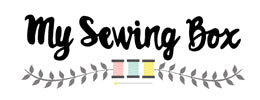Tilly's Tips for Picking the Right Beginner Sewing Project
Tilly's Tips for Picking the Right Beginner Sewing Project

Has the latest season of the Great British Sewing Bee inspired you to sew your own clothes (at a relaxed speed, of course!)? The first step to take is getting to grips with your sewing machine and how everything works. If you want some help with this step, you could take my Make Friends with a Sewing Machine online workshop and you’ll feel confident in no time!
Don’t tell me, you're itching to make something now? So what garment project should you choose to get started? There are so many sewing patterns out there, it can be a little overwhelming when you just want to start you off on your sewing journey!
Here are my tips for choosing a sewing project that's nice and easy for beginners…



1) Start with simple construction
Ease yourself in gently with a project that doesn’t require tricky techniques or precision sewing. Look for straight lines and not too many pieces, and avoid details such as darts, gathering and pleating until you’ve got a few makes under your (homemade) belt. Start simple, and you can progress to the more complex projects later on.
Try these cute and easy-peasy projects to show you the basics of construction - the Dominique skirt, which is basically sewing straight lines, and the Jaimie pyjamas, which come together quickly and easily (plus there's a free video tutorial for sewing them from start to finish!).


2) Check the fabric suggestions
Just as important as simple construction, check that the project is compatible with fabric that's easy to sew. While you’re still getting used to your sewing machine, the last thing you want to do is sew material such as silk which will slip and slide all over your machine, a stretchy jersey that can result in popped seams or stretched hems if you don't know what you're doing, or a delicate material that can pucker and snag.
Fabrics that are great to start with include woven cottons, linen, chambray or lighter weight denim. These materials all lie flat, press well and don’t slip around as you're working with them. They come in lots of tempting prints (patterned prints hide dodgy stitching!) and are easy to find in fabric shops and department stores.
Give a cotton print a whirl with the Jaimie pyjamas, or try a chambray or linen to make an easy breezy Stevie tunic.



3) Avoid fiddly fastenings
Inserting zips or getting to grips with the buttonhole function on your sewing machine can be a little daunting to new stitchers. If you don’t feel ready to sew zips and buttonholes just yet, don’t! Choose a project without fastenings for now, such as the Safiya trousers from my book Make It Simple, which are elasticated at the waist, the Lotta dress or Bettine dress which you can just throw over your head, or the Stevie tunic which fastens at the back neck with a tie or hairband (yes, really!).
You might want to avoid set-in sleeves too - the kind that you insert into the armhole as a tube - until you're more confident with your sewing. Bettine and Stevie are both great beginner projects as they have "grown-on" sleeves which are cut and sewn in one with the bodice. Hooray!


4) Pick something that’s easy to fit
One of the best things about making your own clothes is that you can tailor them to fit you. If you've ever struggled in a shop changing room, this will be a welcome relief!
However, since we’re all different shapes, getting a fitted bodice or trousers to mould perfectly around your lady curves can sometimes take a bit of work - so save the fun of a very fitted garment for later. Choose a simpler shape, such as the A-line Miette skirt which you can adjust the fit of with the waist ties. The Cleo dungaree dress is easy to fit too, as the style only really needs to fit your hips - hooray!


5) Make it again and again
My final tip for beginner sewing projects is to choose something you can see yourself making more than once. Practising the techniques and steps in a pattern a second (or third) time is great for cementing what you’ve learnt, and it will make you feel good about your progress.
Wishing you lots of fun with your sewing projects!
Shop Tilly and the Buttons’ beginner sewing patterns!
Photos by Jane Looker, Fanni Williams and Make It Simple photos by Ellie Smith

